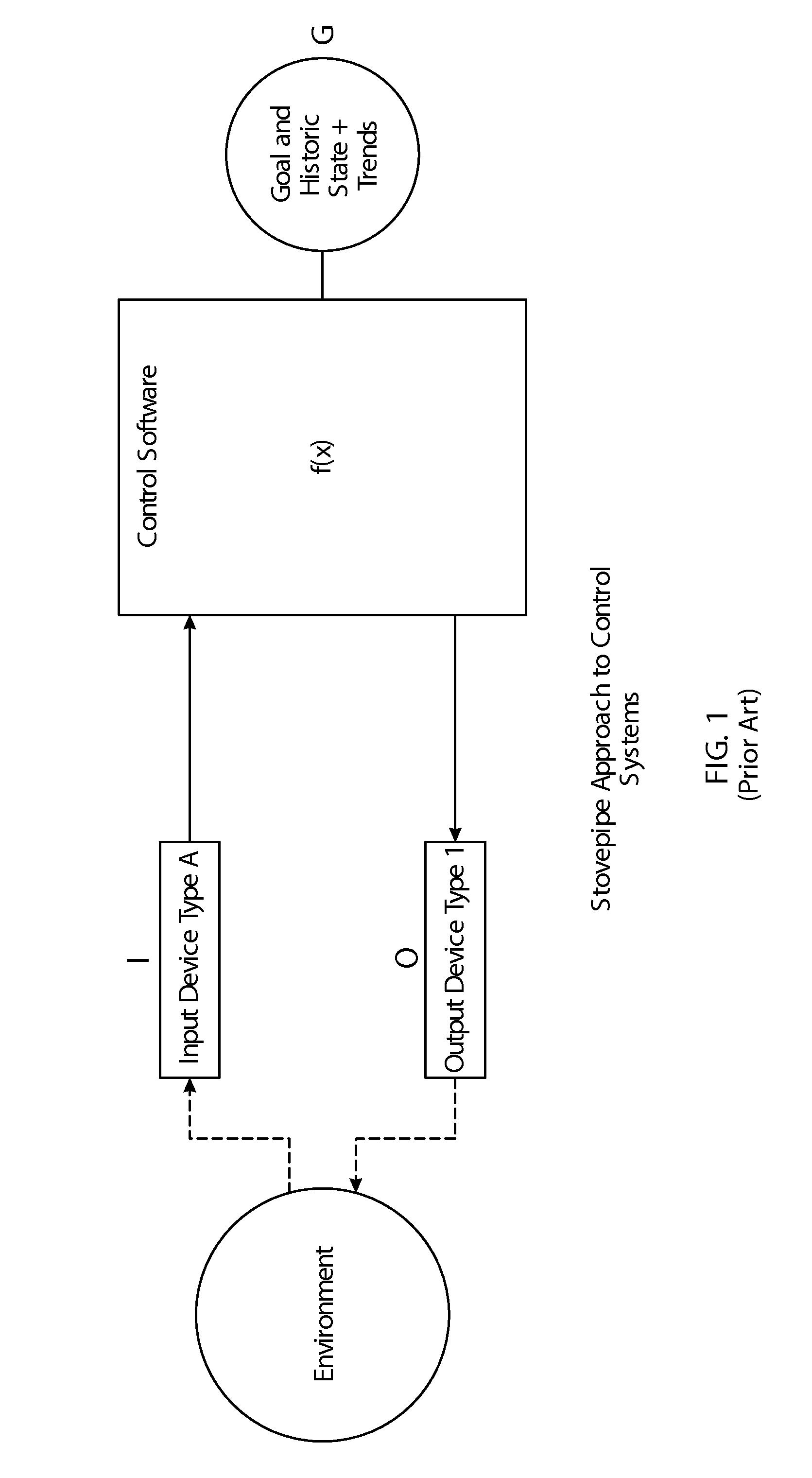[0016]In some implementations described herein, components may be developed independently within a system and system of systems framework that allows developers to use a heterogeneous mix of specifications, hardware, and software rather than the current approach of attempting to force the use of a single standard. In some examples, this framework allows previously incompatible components and technologies, developed independently or not, to be integrated into a system without the re-development or re-engineering of each component. In some embodiments, Interface Modules—for example, Hardware, Conversion, Legacy, and Virtual, known as HIM, CIM, LIM, and VIM respectively—create abstract interfaces that allow a particular element (for example a device) to be treated in terms of the information the component produces / requests. In some implementations, an Information Model replaces (and / or augments) the customized and / or shared templates that have been used heretofore, and through customized objects allows dynamic access to specific parts of the model, persisting through the addition, modification, and deletion of the model as a whole.
[0017]Some embodiments advantageously provide a way to have software and hardware cooperate in an identity-independent fashion that adapts to changing software and / or hardware components in a simple, easy to understand and easy to implement operation and without the need for human intervention (or with relatively minimal human intervention). In some such embodiments, relatively inexperienced programmers or managers may be able to implement systems customized for their needs.
[0022]A modular approach has been taken with certain DIOS implementations. For example, each characteristic that the Information Model abstract, e.g., information representations, programming language, operating system, hardware architecture, security model, and network topology, etc., is implemented as a separate module. During the generation of a custom object, code may be created by these modules that turn the abstract Information Model registrations into relevant native code. Possible advantages of this modular approach include that it allows currently unsupported characteristics to be added easily and new and not-yet-created characteristics to be added in the future. For example, the information representation module may automatically generate the code needed to convert between the form, e.g., data structure(s), units, format, and name, etc., of the same object (or between two objects) in the Information Model. Technical limits in some systems may require a human to create the conversion(s). In such cases, DIOS may implements these as Conversion Interface Modules (CIMs). When two forms of an Information Model object (or a field within an object) are registered for by agents in the system, DIOS embodiments may attempt to automatically generate a CIM to convert between the two information model forms. If the conversion is unsuccessful, DIOS may generate a CIM stub and notify the user that human action may be needed. Additionally, if multiple forms of an object are not used, the CIM need not be generated in some embodiments. Also, if conversion is only desired in one direction, then in some cases a human may implement half of the CIM.
[0026]This disclosure describes embodiments of a system with methods of representation for data from different components and the supporting framework that is use to maintain system cohesiveness. The framework is advantageous for the fast and easy development and deployment of robotic control systems, which may be used, for example, to control any machine that provides a degree of mechanized or digital work, in a variety of differing applications with a variety of differing components. This disclosure describes embodiments of a method for enabling disparate components to communicate in a manner such that if a component is removed and replaced with a differing component that produces the same information, the system will automatically, if relevant CIMs / HIMs / LIMs / VIMs are present, adjust and compensate for the new component such that normal operation is maintained without the need for human interaction. The method may be advantageous for the practical design and implementation of any robotic control system. It also may be advantageous for systems that are desired to scale from a single, specific set of hardware and software components to another unique, potentially disparate, set of hardware and software components with minimal or no modification to the remaining original components of the system.
[0027]In one embodiment, a computer-implemented method of providing an information model for a control system is provided. The information model may facilitate communication of information among agents of the control system. The method comprises organizing information in the information model into a hierarchy of information objects stored in a memory. The information objects may comprise one or more fields defined using abstract primitives in a schema. In some embodiments, at least one of the information objects has a first form and a second form that is different from the first form. The method also comprises associating a publishing agent with a first subset of the information objects in the hierarchy. The first subset represents information that the publishing agent can produce for other agents. The method also comprises associating a subscribing agent with a second subset of the information objects in the hierarchy. The second subset represents information that the subscribing agent can request from other agents. The method also comprises communicating to the subscribing agent information produced by the publishing agent if there is at least one information object in common between the first subset and the second subset. In some embodiments, the information is communicated without requiring knowledge by the subscribing agent of the publishing agent prior to the communication or knowledge by the publishing agent of the subscribing agent prior to the communication.
 Login to View More
Login to View More  Login to View More
Login to View More 


